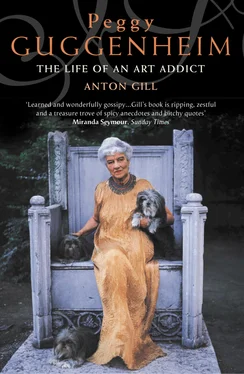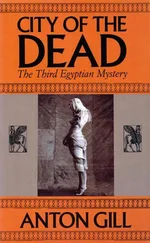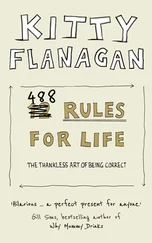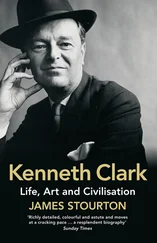The violence implicit in the stories was often visited on children in real life. Ben and Florette may have cared for their children, but they were content to leave them for most of the time in the hands of their nurses and governesses, and these women proved at times to be as awful as the monsters of fiction. Peggy’s cousin Harold Loeb vividly remembered a governess who would lock him in a cupboard and then insult his family through the door. Peggy remembered ‘a nurse who threatened to cut out my tongue if I dared to repeat to my mother the foul things she said to me’. She was brave enough to ignore this injunction, and, to her credit, as soon as Florette knew the truth, the nurse was dismissed. But it is small wonder that the dark and narrow staircase that led to the fifth floor and the servants’ quarters filled Peggy’s childish imagination with dread. As for the tutors, while it was Ben’s intention to give his daughters the best education possible, there is little evidence in Peggy’s or Hazel’s later grasp of grammar that he got value for his money.
Discipline and education were not the only trials that had to be survived:
I was not at all strong and my parents were perpetually fussing about my health. They imagined I had all sorts of illnesses and were forever taking me to doctors. At one period of my life, when I was about ten, they decided I had some intestinal disturbance and found a doctor who ordered me to have colonic irrigations. These were administered by Hazel’s nurse and, as she was quite unqualified for her task, the result was catastrophic. I got an acute attack of appendicitis and was rushed off to hospital at midnight and operated on. For days I was kept in ignorance of the operation since they thought I was too young to be told. However, I did not believe their silly stories and insisted that my stomach had been cut open.
Soon after this, my sister Benita developed the whooping cough and we had to be separated lest I catch it and cough open my newly healed, and let me add, enormous wound. My mother took a house in Lakewood, New Jersey, for herself and Benita, and I was sent to a hotel with a trained nurse. Needless to say I passed a lonely winter and only occasionally was I permitted to speak to Benita on the street and at a great distance. My mother had several nieces who were marriageable and she was perpetually giving house parties for them while she shut poor Benita up in a wing of the house. As a result Benita became melancholic.
There were compensations. Peggy added a note which indicates something of her future: ‘I must have been very precocious and spoiled, since I was allowed to visit my mother and entertain her visitors. I fell in love with one of them. His name was Max Rossbach and he taught me to play pool.’ She also mentions taking lessons with a girl called Dulcie Sulzberger (of the New York Times Sulzbergers); ‘she had two brothers who fascinated me, one in particular, Marion’. At fourteen, Peggy fell in love with her riding teacher, ‘a fascinating Irishman who flirted with all his pupils’, after she had taken up riding again following an accident. Her horse had bolted when disturbed by some roller-skating boys, thrown her and dragged her by the stirrup where her foot was caught. She damaged an ankle, broke her jaw and lost a tooth. The rest of the story is another testimony to her early confrontation with pain, and there is a significant reference to her undergoing a ‘process of being beautified’, which provides a clue concerning her lifelong preoccupation with and selfconsciousness about her looks:
A policeman, finding the tooth in the mud, returned it to me in a letter, and the next day the dentist, after disinfecting it, pushed it back into its original position. This did not end my troubles. My jaw had to be set. During the operation a great battle took place among the attending [dental] surgeons. Finally, one of them triumphed over the other and shook my poor jaw into shape. The vanquished dentist, who was called Buxbaum, never got over this. He felt he had superior rights over my mouth, as he had been straightening my teeth for years. The only good that came out of this was that it put an end to the agonies I had been suffering in the process of being beautified. Now that had to end. The first danger incurred was the possibility of being blood-poisoned. When that passed, the only risk I ran was of getting hit in the mouth and losing my tooth again before it was properly implanted. In those days my sole opponents were tennis balls, so that when I played tennis I conceived the bright idea of tying a tea-strainer in front of my mouth. Anyone seeing me must have thought I had hydrophobia. When it was all over, my father received a bill for seven thousand five hundred dollars from the dentist who had never admitted his defeat. My father persuaded this gentleman reluctantly to accept two thousand.
The young Peggy had other difficulties to surmount. All her life she suffered from weak ankles, and when, as a child, she was forced to go ice-skating in Central Park, her memories of the agonies of both cold and pain were such that she avoided the park ever after – though during her reluctant return to New York in the Second World War her friend and colleague the art historian and curator Alfred Barr did persuade her to visit it once more – ‘but everything had changed. Only the Ramble with its old castle remained, true to my childhood memories.’ But the park wasn’t all bad. Peggy remembered driving in it when very young ‘in an electric brougham’ with her mother. She liked the look of ‘a certain rock on the East Drive that resembled a panther about to spring. I called it “the cat” and whenever we passed it I pretended to telephone to it to say hello.’ There were other diversions. The actor William Gillette wrote and starred in a popular play about the Civil War called Secret Service in 1895, which played in New York when Peggy was a child: ‘I went to all his matinées and virtually screamed to warn him when I thought he was going to be shot by an enemy.’ And there were other early delights, which may not have compensated for the horrors but certainly prompted fond memories later:
The only toys I can remember were a rocking horse with an enormous rump and a doll’s house containing bearskin rugs and beautiful crystal chandeliers. The doll’s house must have left me with a fearful nostalgia, because for years I tried to reproduce it for my daughter. I spent months papering walls and buying objects to furnish her house. In fact I still can’t resist buying toys. I immediately give them away to children but I must buy them for my own delight. I also remember a glass cabinet filled with tiny hand-carved ivory and silver furniture, which had an old-fashioned brass key. I kept the cabinet locked and allowed no-one to touch my treasures.
The presence of an early car, and the casual knowledge of a telephone, as well as access to riding and tennis, to a little girl at the beginning of the twentieth century are indications of the world of privilege into which Peggy had been born. She enjoyed other benefits, which may not have compensated for the loneliness of her life and the nastiness of those in authority over her, but did widen her horizons. From very early on the girls were taken to Europe for the summers. Florette had plenty of Seligman relations – the family concern was by now an international merchant bank – in London and Paris, and they also took in the fashionable watering-places and spas of France and Germany, Monte Carlo and Vienna. Benita and Peggy especially benefited from this, as by the time Hazel was born Ben was beginning to show a greater preference for travelling alone. By 1904 Peggy’s father had begun to take mistresses. There was even a live-in nurse, perhaps the first of many amours , whose job was to massage Ben’s head, since he suffered from neuralgia. Florette, never quite sure that the girl was her husband’s lover, nevertheless blamed her for being an evil influence, and in the end she was dismissed. But Ben’s sisters remained on good terms with the nurse, which turned Florette against them, and led to family rows. ‘All this affected my childhood,’ remarks Peggy dryly. ‘I was perpetually being dragged into my parents’ troubles and it made me precocious.’ She adds: ‘I adored my father because he was fascinating and handsome, and because he loved me. But I suffered very much as he made my mother unhappy, and sometimes I fought with him over it.’
Читать дальше












